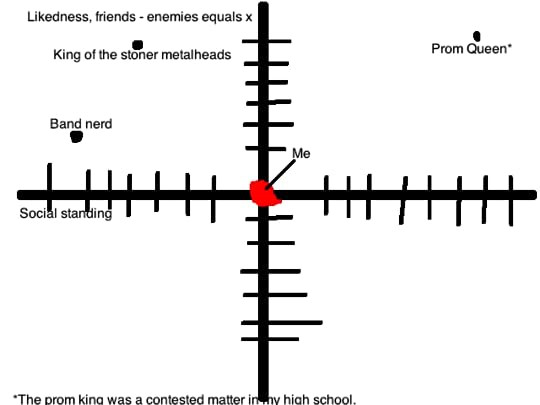John Green’s Paper Towns has resonated with readers for its poignant exploration of adolescence, identity, and the often-misleading nature of appearances. This review delves into the novel’s themes, characters, and impact, drawing parallels to personal experiences and offering a fresh perspective on this beloved young adult novel.
Like many, my high school experience was far from the idealized version often portrayed in media. Popularity felt like an exclusive club, and for many of us, navigating the social hierarchy was more about invisibility than influence. If high school popularity were a graph, mine would resemble a flat line at the very bottom, not quite an outcast, but certainly not part of the in-crowd.
 High school popularity graph depicting a low, flat line, symbolizing the author's experience of being a "non-entity" in high school, relatable to themes in John Green's Paper Towns.
High school popularity graph depicting a low, flat line, symbolizing the author's experience of being a "non-entity" in high school, relatable to themes in John Green's Paper Towns.
This sense of being on the periphery is something I connected with deeply in Paper Towns. Quentin Jacobsen, the protagonist, is not a social pariah, but he’s far from popular. He exists in the background, nursing a long-held infatuation with the enigmatic Margo Roth Spiegelman. Unlike the typical high school narrative filled with quirky sidekicks and clear social circles, both Quentin’s and my own high school reality felt more muted, more about quiet observation than active participation.
Relating to Quentin’s Infatuation and Margo’s Mystery
Quentin’s deep fascination with Margo, a girl he sees as “cute, awesome, and badass,” mirrors the intense, often idealized crushes of adolescence. His actions, which he later recognizes as “uber-creepy and stalkerish,” stem from a place of awkward admiration and a desperate attempt to connect with someone who seems so much more vibrant and alive.
This dynamic resonated with my own experience of being infatuated with a girl in high school. While my actions thankfully weren’t as extreme as Quentin’s, the feeling of being completely captivated by someone who seemed unattainable and effortlessly cool was incredibly familiar. Like Quentin, my attempts to get closer were clumsy and perhaps not entirely well-received, but they did lead to a period of genuine friendship.
Just as Margo disappears from Quentin’s life, the girl I admired also moved away before graduation. This sense of fleeting connection and the bittersweet nature of teenage relationships are central themes in Paper Towns and reflect the transient nature of adolescence itself. Perhaps this personal resonance is part of why Paper Towns struck such a chord. It’s a well-written book, undoubtedly, but it also taps into universal experiences of teenage longing, invisibility, and the search for meaning.
The Mountain Goats and Soundtrack of Paper Towns
John Green’s inclusion of The Mountain Goats in Paper Towns adds another layer of depth for those familiar with the band’s music. The book opens with a quote from “Game Shows Touch Our Lives,” a song by The Mountain Goats, specifically from their album Tallahassee. This album, known for its bleak portrayal of a troubled relationship in Florida, might seem at odds with the adventurous spirit of Paper Towns. However, this juxtaposition is intriguing.
The characters in Paper Towns are portrayed as having “awesome taste in music” for listening to The Mountain Goats. This detail hints at a complexity beneath the surface of these seemingly ordinary teenagers. It suggests a shared sensibility that appreciates the melancholic and introspective, even amidst the excitement of their road trip. While Paper Towns ultimately aims for a more hopeful outlook than the often-dark narratives of Tallahassee, the inclusion of The Mountain Goats adds a layer of emotional depth and complexity to the story. The song “New Chevrolet in Flames,” another Mountain Goats track from the same era, even evokes the kind of adventurous and slightly rebellious spirit associated with Margo’s character.
Spoiler Territory: A Minor Plot Inconsistency
While Paper Towns is a captivating read, there is a minor geographical detail that raises a question. When Quentin is trying to locate Margo, Radar states that her location is “nineteen hours and four minutes away.” This leads Quentin to believe she is incredibly far, justifying a long drive. However, the destination is revealed to be a “paper town” near Woodstock, New York.
The book suggests that driving from Orlando, Florida, to upstate New York is a more economical and logical choice than flying. This is debatable. The cost of gas and provisions for a near non-stop drive would likely be substantial, potentially exceeding the cost of a plane ticket, especially from a major tourist hub like Orlando with frequent and often cheap flights.
Furthermore, the travel time is misrepresented. Woodstock, NY, is at most a two-and-a-half-hour drive from New York City, and likely closer to two hours. Eight hours north of New York City would place Margo’s potential location much further north, possibly into Canada. While this is a minor point, it’s a noticeable inconsistency for those familiar with the geography of the East Coast of the United States. Quentin could have realistically flown to Albany, NY, and then rented a car to reach Woodstock, which might have been a more practical approach. The challenge would likely have been the car rental for an 18-year-old, not the distance itself.
Favorite Line: Margo’s Wit
Despite minor plot quibbles, Paper Towns is filled with memorable moments and sharp dialogue. One standout line, delivered by Margo, perfectly encapsulates her witty and irreverent personality: “It’s a penis,” Margo said, “in the same sense that Rhode Island is a state: it may have an illustrious history, but it sure isn’t big.” This line is both humorous and insightful, reflecting Margo’s ability to cut through pretense and offer a uniquely cynical yet insightful perspective on the world.
Final Thoughts: Why Paper Towns Resonates
In conclusion, while this review may not be as eloquently crafted as John Green’s prose, hopefully it offers some worthwhile insights into why Paper Towns is such a compelling novel. It’s a book that captures the awkwardness, the longing, and the yearning for connection that defines adolescence. It explores the illusion of knowing someone and the reality of paper towns – places and people that appear real but are ultimately constructs of our own perceptions. Paper Towns is a journey worth taking, and it’s a book that stays with you long after you’ve turned the final page. If you haven’t read it yet, I highly recommend experiencing the mystery and introspection of Paper Towns for yourself.

